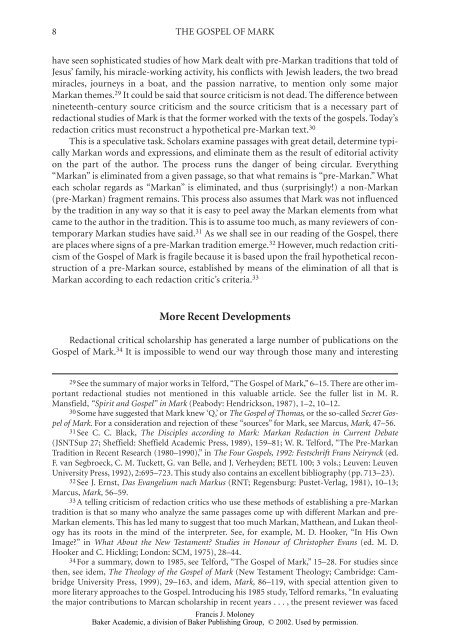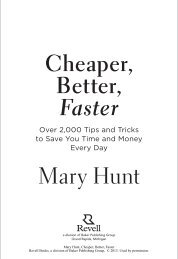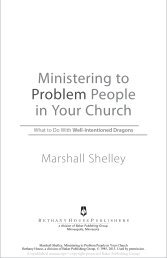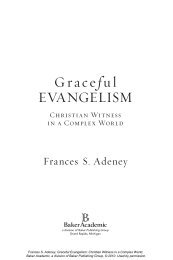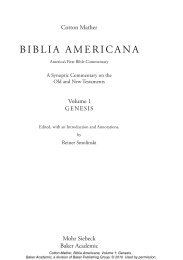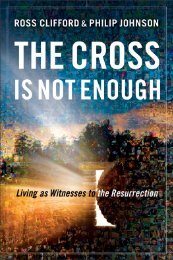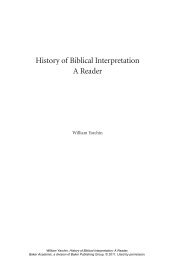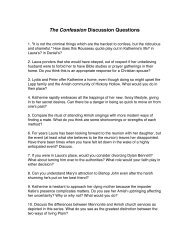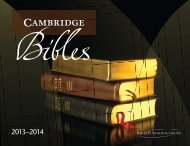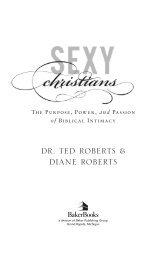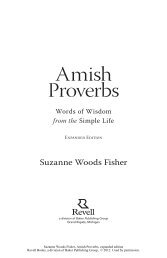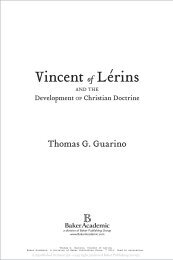the gospel of mark a commentary - Baker Publishing Group
the gospel of mark a commentary - Baker Publishing Group
the gospel of mark a commentary - Baker Publishing Group
You also want an ePaper? Increase the reach of your titles
YUMPU automatically turns print PDFs into web optimized ePapers that Google loves.
8 THE GOSPEL OF MARK<br />
have seen sophisticated studies <strong>of</strong> how Mark dealt with pre-Markan traditions that told <strong>of</strong><br />
Jesus’ family, his miracle-working activity, his conflicts with Jewish leaders, <strong>the</strong> two bread<br />
miracles, journeys in a boat, and <strong>the</strong> passion narrative, to mention only some major<br />
Markan <strong>the</strong>mes. 29 It could be said that source criticism is not dead. The difference between<br />
nineteenth-century source criticism and <strong>the</strong> source criticism that is a necessary part <strong>of</strong><br />
redactional studies <strong>of</strong> Mark is that <strong>the</strong> former worked with <strong>the</strong> texts <strong>of</strong> <strong>the</strong> <strong>gospel</strong>s. Today’s<br />
redaction critics must reconstruct a hypo<strong>the</strong>tical pre-Markan text. 30<br />
This is a speculative task. Scholars examine passages with great detail, determine typically<br />
Markan words and expressions, and eliminate <strong>the</strong>m as <strong>the</strong> result <strong>of</strong> editorial activity<br />
on <strong>the</strong> part <strong>of</strong> <strong>the</strong> author. The process runs <strong>the</strong> danger <strong>of</strong> being circular. Everything<br />
“Markan” is eliminated from a given passage, so that what remains is “pre-Markan.” What<br />
eachscholarregardsas“Markan”iseliminated,andthus(surprisingly!)anon-Markan<br />
(pre-Markan) fragment remains. This process also assumes that Mark was not influenced<br />
by <strong>the</strong> tradition in any way so that it is easy to peel away <strong>the</strong> Markan elements from what<br />
came to <strong>the</strong> author in <strong>the</strong> tradition. This is to assume too much, as many reviewers <strong>of</strong> contemporary<br />
Markan studies have said. 31 As we shall see in our reading <strong>of</strong> <strong>the</strong> Gospel, <strong>the</strong>re<br />
are places where signs <strong>of</strong> a pre-Markan tradition emerge. 32 However, much redaction criticism<br />
<strong>of</strong> <strong>the</strong> Gospel <strong>of</strong> Mark is fragile because it is based upon <strong>the</strong> frail hypo<strong>the</strong>tical reconstruction<br />
<strong>of</strong> a pre-Markan source, established by means <strong>of</strong> <strong>the</strong> elimination <strong>of</strong> all that is<br />
Markan according to each redaction critic’s criteria. 33<br />
More Recent Developments<br />
Redactional critical scholarship has generated a large number <strong>of</strong> publications on <strong>the</strong><br />
Gospel <strong>of</strong> Mark. 34 It is impossible to wend our way through those many and interesting<br />
29See <strong>the</strong> summary <strong>of</strong> major works in Telford, “The Gospel <strong>of</strong> Mark,” 6–15. There are o<strong>the</strong>r important<br />
redactional studies not mentioned in this valuable article. See <strong>the</strong> fuller list in M. R.<br />
Mansfield, “Spirit and Gospel” in Mark (Peabody: Hendrickson, 1987), 1–2, 10–12.<br />
30Some have suggested that Mark knew ‘Q,’ or The Gospel <strong>of</strong> Thomas, or <strong>the</strong> so-called Secret Gospel<br />
<strong>of</strong> Mark. For a consideration and rejection <strong>of</strong> <strong>the</strong>se “sources” for Mark, see Marcus, Mark, 47–56.<br />
31SeeC.C.Black,The Disciples according to Mark: Markan Redaction in Current Debate<br />
(JSNTSup 27; Sheffield: Sheffield Academic Press, 1989), 159–81; W. R. Telford, “The Pre-Markan<br />
Tradition in Recent Research (1980–1990),” in The Four Gospels, 1992: Festschrift Frans Neirynck (ed.<br />
F. van Segbroeck, C. M. Tuckett, G. van Belle, and J. Verheyden; BETL 100; 3 vols.; Leuven: Leuven<br />
University Press, 1992), 2:695–723. This study also contains an excellent bibliography (pp. 713–23).<br />
32See J. Ernst, Das Evangelium nach Markus (RNT; Regensburg: Pustet-Verlag, 1981), 10–13;<br />
Marcus, Mark, 56–59.<br />
33A telling criticism <strong>of</strong> redaction critics who use <strong>the</strong>se methods <strong>of</strong> establishing a pre-Markan<br />
tradition is that so many who analyze <strong>the</strong> same passages come up with different Markan and pre-<br />
Markan elements. This has led many to suggest that too much Markan, Mat<strong>the</strong>an, and Lukan <strong>the</strong>ology<br />
has its roots in <strong>the</strong> mind <strong>of</strong> <strong>the</strong> interpreter. See, for example, M. D. Hooker, “In His Own<br />
Image?” in What About <strong>the</strong> New Testament? Studies in Honour <strong>of</strong> Christopher Evans (ed. M. D.<br />
Hooker and C. Hickling; London: SCM, 1975), 28–44.<br />
34For a summary, down to 1985, see Telford, “The Gospel <strong>of</strong> Mark,” 15–28. For studies since<br />
<strong>the</strong>n, see idem, TheTheology<strong>of</strong><strong>the</strong>Gospel<strong>of</strong>Mark(New Testament Theology; Cambridge: Cambridge<br />
University Press, 1999), 29–163, and idem, Mark, 86–119, with special attention given to<br />
more literary approaches to <strong>the</strong> Gospel. Introducing his 1985 study, Telford re<strong>mark</strong>s, “In evaluating<br />
<strong>the</strong> major contributions to Marcan scholarship in recent years . . . , <strong>the</strong> present reviewer was faced<br />
Francis J. Moloney<br />
<strong>Baker</strong> Academic, a division <strong>of</strong> <strong>Baker</strong> <strong>Publishing</strong> <strong>Group</strong>, © 2002. Used by permission.


